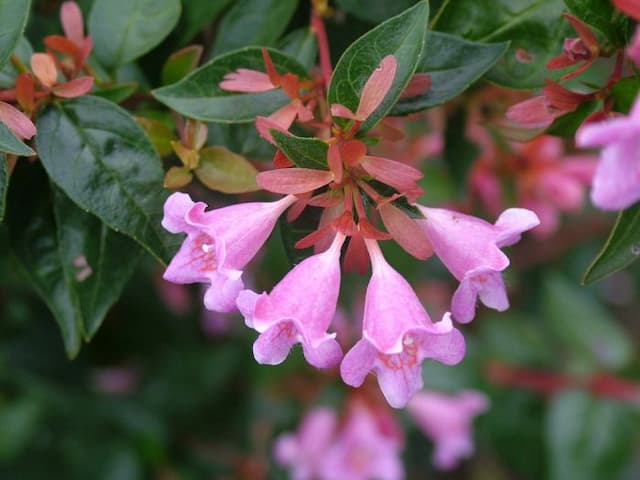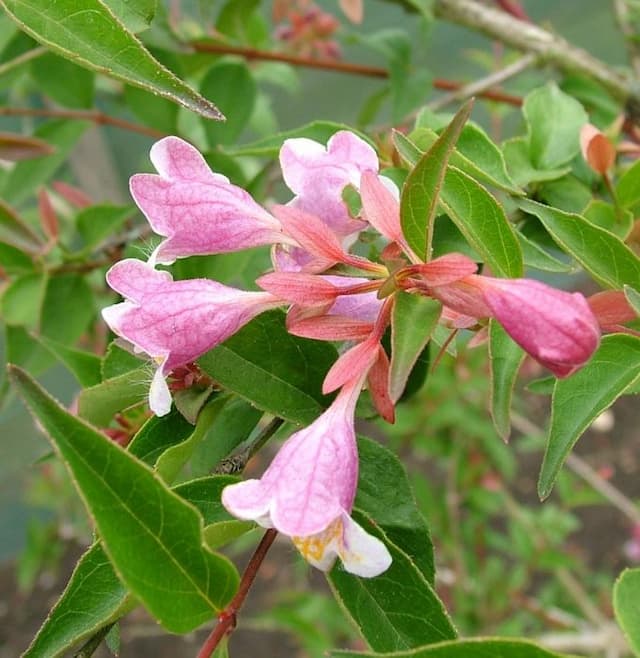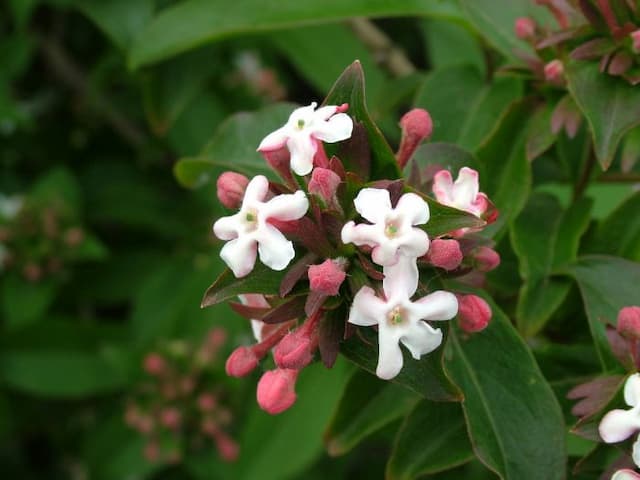Weigela Weigela Picobella Rosa = 'Tvp2'
![weigela [Picobella Rosa]](/_next/image?url=https%3A%2F%2Fplants-admin.emdemapps.com%2Fimages%2Fplants%2F%2Fimages%2F604b5ee2c5ca5.png&w=3840&q=75)
ABOUT
The Weigela Picobella Rosa is a compact shrub that displays an abundant array of trumpet-shaped pink flowers. Its blooms are rich in color, often showcasing a gradient from a deeper pink at the edges to a lighter pink or almost white near the throat. Clustered along the branches, the flowers are a favorite to hummingbirds and provide a long-lasting floral display from late spring into the summer. The foliage of this Weigela consists of ovate leaves that are medium green in tone, creating a lush backdrop that further accentuates the vibrancy of the pink blooms. The leaves' edges are softly serrated, and they have a somewhat glossy appearance that catches the light, adding texture and visual interest even when the plant is not in bloom. Overall, the plant takes on a mounded form with dense growth, making it a versatile choice for garden landscapes where a pop of color and a moderate amount of foliage are desired. The Weigela Picobella Rosa's ornamental appeal makes it well-suited for use in mixed borders, as a stand-alone specimen, or even in decorative containers where its floral show can be appreciated up close.
About this plant
 Names
NamesFamily
Caprifoliaceae
Synonyms
Weigela Picobella Rosa
Common names
Weigela Picobella Rosa 'Tvp2'.
 Toxicity
ToxicityTo humans
Weigela is not known to be toxic to humans. There are no well-documented cases of poisoning or serious health consequences from ingesting Weigela. However, as with many plants, individual allergic reactions or irritations can occur.
To pets
Weigela is generally considered non-toxic to pets as well. It does not appear on the toxic plant lists provided by the ASPCA and other animal welfare organizations. Therefore, pets that ingest Weigela typically do not exhibit serious symptoms of poisoning. However, gastrointestinal upset is possible with the ingestion of any plant material by an animal not used to it.
 Characteristics
CharacteristicsLife cycle
Perennials
Foliage type
Deciduous
Color of leaves
Green
Flower color
Pink
Height
1-2 feet (30-60 cm)
Spread
1-2 feet (30-60 cm)
Plant type
Shrub
Hardiness zones
4
Native area
Asia
Benefits
 General Benefits
General Benefits- Attractive Flowers: Weigela Picobella Rosa produces abundant pink blooms that add a splash of color to the garden or landscape.
- Compact Size: Its small, compact habit makes it suitable for smaller gardens or as a border plant.
- Easy to Grow: It is known to be low-maintenance and easy to care for, making it suitable for novice gardeners.
- Attracts Pollinators: The flowers attract bees, butterflies, and other pollinators, which can help pollinate nearby plants.
- Seasonal Interest: Provides visual interest throughout its blooming season with its attractive foliage and flowers.
- Drought Tolerant: Once established, it has a decent tolerance to drought conditions, reducing the need for frequent watering.
 Medical Properties
Medical PropertiesThis plant is not used for medical purposes.
 Air-purifying Qualities
Air-purifying QualitiesThis plant is not specifically known for air purifying qualities.
 Other Uses
Other Uses- Weigela can be used as a natural dye source, with different parts of the plant yielding varying hues for fabrics and crafts.
- In small gardens, Weigela can be trained to grow in containers, adding a splash of color to patios and balconies.
- Culinary artists sometimes use the flowers of the Weigela to decorate dishes, adding an edible, aesthetic touch to their creations.
- Some wildlife enthusiasts plant Weigela to create a natural habitat for attracting hummingbirds and beneficial insects to the garden.
- Weigela can be used in thematic gardens, such as Victorian or cottage gardens, to provide a historical context to garden designs.
- Photographers often use Weigela gardens as picturesque backdrops for portrait and macro photography sessions.
- Artisans may use the woody branches of Weigela to craft rustic furniture and decorative pieces for home decor.
- Weigela can be incorporated into sensory gardens, where its flowers provide a soft texture and sweet fragrance for the visually impaired.
- During festive seasons, Weigela can be trimmed and used as natural, biodegradable holiday decor both indoors and outdoors.
- Teachers and educators can utilize Weigela plants in school gardens for hands-on lessons in botany and ecology for students.
Interesting Facts
 Feng Shui
Feng ShuiThe Weigela is not used in Feng Shui practice.
 Zodiac Sign Compitability
Zodiac Sign CompitabilityThe Weigela is not used in astrology practice.
 Plant Symbolism
Plant Symbolism- Adaptation: The Weigela is known for its adaptability to various soil types and climates, symbolizing the ability to thrive in differing conditions.
- Romantic Sentiments: With its pink to rose-colored blooms, the Weigela often represents love and affection in the language of flowers.
- Grace: The arching branches and delicate flowers convey a sense of elegance and grace, often reflecting beauty in a peaceful landscape.
- Prosperity: In some cultures, a flowering plant like the Weigela can signify growth and abundance, offering an optimistic outlook on future possibilities.
- Nostalgia: The Weigela's vintage charm may evoke a sense of nostalgia, reminiscent of bygone eras and traditional cottage gardens.
 Water
WaterThe Weigela Picobella should be watered deeply to encourage root growth but should not be overwatered, as this can lead to root rot. Typically, watering once a week with about one-inch of water will suffice, but this can vary depending on climate conditions and soil type. During hot, dry spells, it may need to be watered more frequently, and less often when rainfall is abundant. A good practice is to check the soil's moisture level by sticking a finger into the soil up to the second knuckle; if the soil feels dry, it’s time to water. It's best to water the plant early in the morning or late in the afternoon to reduce evaporation.
 Light
LightThe common Weigela Picobella prefers full sun to partial shade for optimal growth and flowering. Full sun means at least six hours of direct sunlight each day, but it can also perform well with slightly less sunlight. When planted in too much shade, the flowering may be reduced. The ideal spot for this plant is one where it can bask in the morning sun, which is less intense, and receive some afternoon shade, especially in hotter climates.
 Temperature
TemperatureWeigela Picobella tolerates a range of temperatures but performs best in USDA hardiness zones 4 through 8. They can survive in temperatures as low as -30°F and can handle summer high temperatures well into the 90s°F. Always ensure that the plant is well-mulched to protect its roots from extreme temperatures. The ideal temperature range for vigorous growth and blooming lies between 65°F and 75°F during the growing season.
 Pruning
PruningPrune Weigela Picobella immediately after its spring flowering to shape the plant and encourage robust growth for the next season. Pruning out dead or crossed branches also improves air circulation, which is vital to the health of the plant. It's best to prune yearly, but light pruning can be done anytime during the growing season if necessary.
 Cleaning
CleaningAs needed
 Soil
SoilWeigela 'Picobella Rosa' thrives in well-drained soil rich in organic matter; a mixture of loam, peat, and coarse sand can be ideal. The soil pH should be slightly acidic to neutral, ranging from 5.5 to 7.0 for optimal growth.
 Repotting
RepottingWeigela 'Picobella Rosa' generally does not require frequent repotting. Repot once the plant outgrows its pot, which could be every 2-3 years to refresh the soil and provide space for root growth.
 Humidity & Misting
Humidity & MistingWeigela 'Picobella Rosa' prefers moderate humidity levels but is tolerant of a wide range. There's no need for specific humidity control for this robust shrub in a garden setting.
 Suitable locations
Suitable locationsIndoor
Ensure bright light and good air circulation.
Outdoor
Plant in sun to part shade, shelter from strong winds.
Hardiness zone
4-8 USDA
 Life cycle
Life cycleThe life of Weigela 'Picobella Rosa' begins with seed germination, which typically occurs in favorable growing conditions of moist soil and adequate warmth. After germination, seedlings develop into juvenile plants, showing initial foliage growth and establishing a root system. As it enters the vegetative stage, 'Picobella Rosa' experiences significant growth of stems and leaves, and prepares for the flowering phase. The plant then transitions to the reproductive stage, producing clusters of trumpet-shaped pink flowers in late spring to early summer, which attract pollinators and may set seed if conditions permit. After flowering, Weigela 'Picobella Rosa' may go into a period of dormancy, particularly in regions with cold winters, where it conserves energy until the next growing season. Throughout its life, the plant may undergo cycles of growth and dormancy yearly, growing larger and more robust over time, until it reaches maturity and eventually senesces after many years.
 Propogation
PropogationPropogation time
Spring to Summer
The Weigela Picobella Rosa, commonly known as Weigela, is most commonly propagated through softwood cuttings, a method used typically in the late spring to early summer, coinciding with the plant's active growth phase. To propagate Weigela using softwood cuttings, one starts by taking a cutting of about 4 to 6 inches in length (approximately 10 to 15 centimeters), preferably from a healthy, disease-free branch. The cutting should include several leaf nodes and should be taken using a clean, sharp pair of pruning shears. After removing the lower leaves to expose the nodes, the base of the cutting is often dipped in a rooting hormone to encourage root development. Finally, the cutting is placed in a well-draining soil mix, ensuring the exposed nodes are covered, and is kept under moist conditions with adequate light but protected from direct sunlight until roots have established, which typically takes a few weeks.








![Himalayan honeysuckle [Golden Lanterns]](/_next/image?url=https%3A%2F%2Fplants-admin.emdemapps.com%2Fimages%2Fplants%2F%2Fimages%2F604b55302cc87.png&w=640&q=75)
